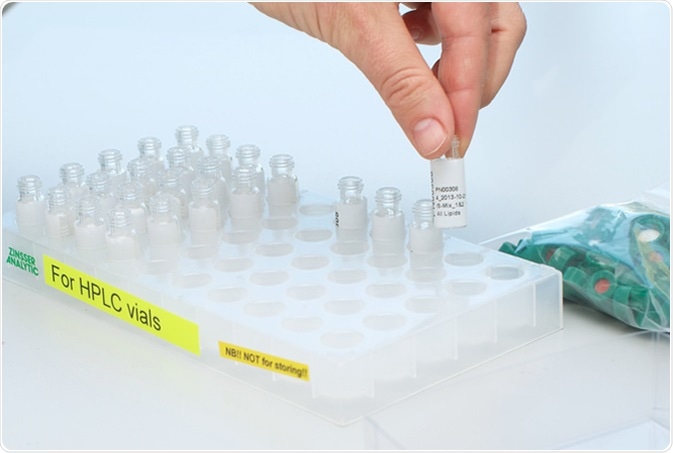The non-targeted metabolomics approach aims to study both known and unknown metabolites. To comprehend the huge chunks of data this may yield, one must couple it with advanced chemometric methods such as multivariate analysis, so that these can be grouped into smaller manageable chunks. The latter may then be studied further either with computer simulation or by experimental investigation, using analytical methods of measurement. This approach can help us discover new target analytes, limited only by the sensitivity and specificity of the techniques used.

Image Credit: Brian Holm / Shutterstock
The challenges connected with this approach include the long time frames involved with processing huge amounts of data, reliance on existing methods of analytical measurement, and newer analytical methods evolved/needed in discovering, identifying, and characterizing newer metabolomes (amid an abundance of well-characterized analytes). The ultimate goal in the nontargeted approach is to identify as many metabolites as possible in the sample.
The Human Metabolome Project (HMP) has devised a variety of methods that can be used for nontargeted analysis. As there is no catalog available for the compounds identified through metabolomic approaches, multiple passes and platforms are in use to compare and contrast the data.
Non-Targeted Approach Process Flow
Broadly, there are five main steps followed in the non-targeted metabolomics approach. They are:
- Biological sample selection
- Data acquisition
- Spectral processing
- Data analysis and metabolite identification
- Biological interpretation
Approaches for Metabolomic Data Generation
After selecting the sample, the next step is to generate data. There are two main approaches used widely to generate metabolomic data, which are:
- Nuclear magnetic resonance (NMR) and
- Mass spectrometry (MS)
NMR is a spectroscopic technique where the magnetic field applied targets the atom nuclei and generates a variety of metabolomic data. As hydrogen is found in abundance in biological samples, it is the most widely targeted nucleus with respect to samples of biological origin. Other atoms that are targeted are carbon and phosphorus, which may provide more information on a particular type of metabolite.
Metabolites of medium to high availability can be found using NMR. In high-throughput studies, 1D-NMR is mostly used. Depending on two frequency axes, 2D-NMR is used. Also, in cases when 1D-NMR cannot identify the compounds, 2D-NMR is employed.
Mass spectrometry methods provide quantitative analysis with a combination of selectivity and sensitivity and the possibility to find metabolites. Unlike NMR, where sample preparation requirements are minimal, in mass spectrometry there is a requisite for the sample preparation step. The spectral data is acquired in a mass-to-charge ratio form. A separation step is followed to reduce the high complexity of the sample. Liquid chromatography columns and gas chromatography columns are the most widely used separation techniques.
Ion Mobility Spectrometry
Human beings come across xenobiotics everyday. The metabolic process of chemicals in the diet or drug components can produce many metabolites. Some metabolites may have a negative effect on the body, therefore it is important to discover the complete metabolic effects of these metabolites. Non-targeted analysis is conducted using a new technique called ion mobility spectrometry (IMS) to identify xenobiotics. Combined with mass spectrometry, this rapid technique aims to discover xenometabolite, as it differentiates between chemical isomers containing the same number of atoms across different configurations. Studies are in progress for coupling RapidFire cartridge approaches and Field Assymetric Waveforms.
NMR techniques have low sensitivity, whereas liquid chromatography coupled with mass spectrometry or gas chromatography coupled with mass spectrometry are of high sensitivity. CE coupled with mass spectrometry is of medium sensitivity.
Spectral Processing and Spectral Database
A methodological approach is spectral processing, to identify and quantify the metabolic features such as spectral peak areas, metabolite concentrations, and spectral bin areas in the sample spectra. These metabolomic spectra are processed, either jointly or sequentially, and the resultant data are arranged in such a way that they serve as input for the next step of analysis.
To identify the metabolite, it is essential to have a metabolite spectral database. The performance of the algorithms that is identified is based on the volume and quality of the data stored in the database.
A list of a few available spectral databases is given below:
The Human Metabolome Database (HMDB) has 1,579 metabolites with spectra and 41,806 metabolite entries. METLIN has 12,057 metabolites with spectra and 240,516 metabolite entries. LMSD has 37,500 lipid structures with spectra. MassBank has 40,889 metabolites with spectra and 2,337 metabolites. Birmingham Metabolite library has 3,328 metabolites with spectra and 208 metabolites. RIKEN has 1589 metabolites for the plant Arabidopsis.
Data Analysis and Sample Interpretation
Data analysis is done using methods such as univariate analysis, multivariate analysis (both supervised and unsupervised), and multiway methods and the biomarker candidate is identified. The analyzed metabolomic data is used in building classification models to describe the data under observation. Finally, using pathway analysis or correlation-based network analysis biological interpretation of the samples is done.
Jessica Prenni on Non-Targeted Metabolite Profiling
Further Reading
Last Updated: Aug 23, 2018